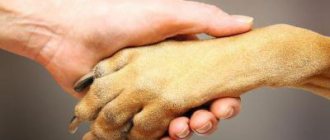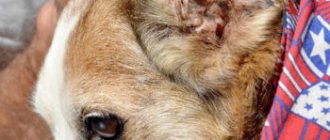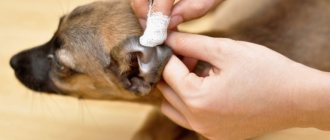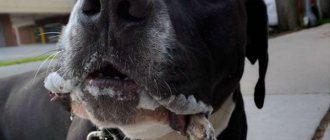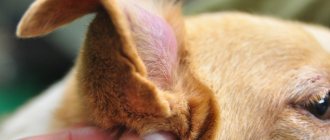Every breeder of a four-legged friend is happy when his dog is healthy. The pet runs around the lawn, around the house, and plays with children.
But it also happens that the dog turns from an active tomboy into a decrepit old woman. She cannot move normally, she limps, and sometimes she cannot even stand up. The owner must urgently respond to this change in behavior, otherwise possible paresis can lead to complete paralysis and even death.
Difference from paralysis
It will be difficult for a person who is not familiar with the distinctive signs of paresis and paralysis to get ahead of what his dog is facing. In the body of an animal, the processes of these two diseases are almost identical. Paresis, unlike paralysis, allows the dog to move, albeit slowly. We can say that paresis is incomplete paralysis.
Partial paralysis needs to be treated. Otherwise, this will lead to complete failure of the dog’s hind limbs. The disease is often found among pets. The most common cause of paresis of the hind limbs is considered to be diseases of the spinal system. Any injury, even a minor one, can lead to this disease.
What is the treatment for paresis in a dog?
Depending on the type of illness (such as a central nervous system disorder), the treatment will be different:
- 1. Functional paralysis - occurs in the case of the harmful influence of exogenous factors ((from the outside) or mental disorders (extremely stressful situations). The most common concept in professional circles is “nervous distemper”, when a pet without an owner, having experienced stress, simply “gives up its paws.”
- 2.Organic paralysis is a disruption of the functioning of neurons due to physical trauma. Among such effects it is worth noting injuries, paresis of the hind limbs in dogs, infectious diseases or neoplasms.
- 3. Central paralysis - gradually develops and affects various muscle groups. Based on irreversible changes, the muscles are affected and modified, but the reflexes are preserved.
- 4. Peripheral paralysis is the most common variant, called “failure” of the limbs. Appears due to the death of neurons. The disease is fleeting, which affects the rate at which the dog loses sensitivity in its paws. The quadruped literally loses the ability to move normally in a matter of days.
Varieties of paralysis are nothing more than a consequence, and not the cause of the disease. As a reason for complications, one can note, first of all, injuries, as well as the appearance of neoplasms, infections, inflammation and stroke.
Stages of neurological disorder
Depending on how the dog’s disease progresses, treatment is prescribed. Paresis has several stages, and veterinarians rate it using a six-point system.
Outpatient
Outpatient paresis begins with the third stage of the disease:
- sensitivity is preserved in the hind limbs;
- walking is difficult;
- The dog is on its feet, but not stable.
Late
Non-ambulatory paresis begins with the fourth stage of the disease. Its signs are as follows:
- sensitivity decreases;
- the body reacts to severe pain upon palpation;
- the animal cannot stand or walk.
At the fifth and sixth stages of paresis, the dog may no longer respond to pain.
In medicine, ambulatory paresis is called partial, that is, she can move, although not fully. With non-ambulatory paresis, that is, complete, there is no control over movements. The animal moves with difficulty, dragging the rear part of its body behind it.
If with ambulatory paresis you can get by with light therapeutic intervention, then in the last stage of non-ambulatory paresis only surgery can help.
Prevention of paralysis in dogs
There are no vaccinations or “magic pills” that guarantee that a dog will not get paralysis. Future and current owners of dachshunds, basset hounds, any breed with an elongated body, pointers, greyhounds, hounds - your pets are at risk. A strictly balanced diet, vitamin supplements and regular visits to the veterinarian - for life and no exceptions.
- Always check your dog after a walk for injuries and ticks.
- Feed your pet only fresh food! By any means, wean your dog from picking up food from the ground - botulism, which lives in “rotten meat”, is complicated by paralysis and death too.
- Also, by any means, teach your dog not to react to cats, birds and other living creatures - if carried away by the chase, the pet will easily run out onto the roadway.
- The most common cause of traumatic brain injuries and spinal fractures is cars. Education, leash and more education!
- When walking with your pet, always cross the road only in the designated place; if the crossing is busy, start moving with the flow of people. Even if your pet gets lost, it will look for crossings and run across the roadway, focusing on the flow of people, which will reduce the risk of getting run over.
Types of paw disease
Paresis is divided into several types, based on the level of damage to the spinal cord and the limbs affected by the disease. Let's look at the types of diseases that are common in dogs.
Paraparesis
With this type of disease, both forelimbs and both hind limbs can be affected. The central nervous system or peripheral is affected.
Tetraparesis
All four paws are affected. Movements become limited, the disease develops due to neurological lesions of various types. These may be complications after:
- acute cerebrovascular accident;
- myasthenia gravis;
- thrombosis;
- neurosurgery and much more.
Hemiparesis
The causes of the disease are the same as for tetraparesis. Only paresis of the upper or lower extremities occurs. Also, hemiparesis can be left-sided or right-sided.
Physiological side of paralysis
Muscles that do not receive “orders” from the brain are constantly in a relaxed state and the dog cannot control the limbs. The causes of disorders are always related to the central nervous system, but are divided by origin - damage to the brain or spinal cord. Most often, the disease is acquired and can be expressed:
- Monoplegia is paralysis of one limb.
- Paraplegia is a paired paralysis of a dog’s paws that affects the front or rear limbs. The most common type, caused by spinal cord injury, sciatica, and hip dysplasia.
- Tetraplegia – damage to all limbs.
- Hemiplegia - damage to the left or right paws and/or sides of the body.
- Triangular nerve palsy - the dog cannot lift its jaw.
The prognosis of treatment and its appropriateness depend on the type of nervous system disorder:
- Functional paralysis - occurs due to the harmful influence of external factors or mental disorders (severe stress). The phenomenon may be temporary and resolve without intervention. The most common example is the so-called nervous distemper, a pet temporarily abandoned by its owner becomes so worried that it “falls on its paws.”
- Organic paralysis is a disruption of the functioning of neurons associated with a physical impact on the spinal cord or brain - trauma, neoplasms or infectious lesions, most often tick paralysis, enteritis, plague.
- Central paralysis is a gradually developing disease that affects different muscle groups. Due to irreversible changes, the affected smooth muscles are modified and lose normal physiological properties, while during the course of the disease, reflexes and muscle tone are often preserved.
- Peripheral paralysis is a “classic” picture called “failure” of the limbs. Occurs as a result of damage or death of neurons responsible for muscle tone. The disease progresses quickly, the dog loses sensitivity and “falls on its paws” in a matter of days.
Other organs
You should know and remember that paresis can not only be visible from the outside. Internal organs may also suffer.
Bladder
Paresis of the bladder and other internal organs occurs in dogs. This is due to the presence of a malignant tumor in the body. As it grows, it compresses tissues, which begin to atrophy over time. After this, paresis occurs.
Even if the tumor is small, but its pressure on the internal organs is prolonged, the nervous tissue still begins to lose its functions.
Intestines
The cause may be not only a tumor, but also parasites. The larvae spread throughout the dog's body in the blood and settle in the tissues. The encapsulation process begins, which triggers an effect similar to that of a tumor. It is very scary when intestinal paresis occurs. The animal loses the ability to defecate.
Facial nerve
Infectious diseases can cause facial paresis in dogs. The virus enters the nervous tissue, triggers the inflammatory process and the nervous tissue loses the ability to conduct full impulses.
Other causes
The veterinary literature describes situations where gradual numbness of the body, associated with severe disturbances of water-salt metabolism, developed in dogs suffering from severe forms of exhaustion. Hypothetically, this could happen to a stray animal or a dog whose owners have fed low-quality dry food all its life.
But more often postpartum paresis in dogs develops in a similar way. This is an extremely serious condition that develops in bitches who have just given birth. In rare cases, paresis can “overtake” an animal on the third or fourth day after the birth of the offspring. The pathology develops against the background of a serious lack of calcium in the body, which disrupts the transmission of neuromuscular impulses.
But do not forget about other probable reasons. Like complete paralysis, paresis of the bladder (and other organs) can develop against the background of cancer. When a tumor grows on the surface of the spinal column or directly in the spinal canal, it compresses the surface of the spinal cord. Light compression causes paresis. If the mechanical pressure is strong, or it continues for a sufficiently long time, the nervous tissue atrophies and the animal becomes paralyzed.
Some parasitic pathologies lead to a similar outcome. When worm larvae migrate in search of a “new homeland” throughout the body, they can end up (along with the bloodstream) anywhere. It is bad when larvae settle in the nervous tissue, since during the encapsulation process an effect similar to that of a tumor occurs.
Do puppies have them?
Puppies are not protected from this disease and one can say. They are at even greater risk than adult dogs. Any spinal injury can cause paresis. Puppies are very active and can hurt themselves when playing. Also, severe infectious diseases, in particular plague, can leave behind such complications.
It should be remembered that some breeds have an innate tendency to develop paresis. Due to the special structure of the spine, dachshunds, poodles, basset dogs and French bulldogs often suffer from this disease.
Causes
There are actually many reasons for the occurrence of paresis of various types. Here are a few main ones:
- diseases of the spine;
- spinal injuries;
- malformations of the spine;
- bacterial infection in the bone of the spine;
- excessive activity of the animal;
- risk group (some breeds have an innate tendency to the disease);
- infections;
- inflammation of muscle tissue;
- polyneuritis;
- botulism;
- muscle weakness;
- circulatory disorders in the brain;
- meningitis;
- encephalitis;
- poisoning of the body with chemicals;
- malignant tumor;
- low levels of thyroid hormones;
- polyneuropathy caused by an allergic reaction of the body;
- lack of calcium in the body. This usually occurs in female dogs after giving birth.
Symptoms
The first symptoms that should alert the animal owner:
- the dog stops moving at its usual speed;
- the animal simply drags its hind limbs along;
- the pet can hardly step over a stone on the road and trips over it;
- pain syndromes in the cervical spine, hind limbs;
- urination is difficult, or vice versa, urinary incontinence occurs;
- inability to control bowel movements;
- constipation;
- dyspnea;
- muscle twitching;
- panic attacks;
- lack of appetite, thirst.
Symptoms of the disease depend on where the damaged area is located.
Application of DENS for the treatment of dogs and cats
The search for new and adaptation of existing methods and techniques for the treatment of various pathologies of small domestic animals remains a very pressing problem for veterinary practice today. Nowadays, the method of low-frequency electrotherapy is increasingly used - dynamic electrical neurostimulation (DENS), which has pronounced analgesic, anti-edematous and anti-inflammatory effects. DENS is a method of therapeutic effects on the receptor apparatus of the skin, biologically active points, sensitive afferent conductors in the pain zone.
In veterinary practice, we often encounter degenerative changes in the spine and hip joints of animals. The main clinical signs of this pathology are manifested by lethargy, reluctance to walk, stiffness of movement, difficulty going up and down stairs, jumping onto a chair or into a car, severe pain and inability to stand on your “legs,” and initial lameness. In advanced cases, ataxia is observed, up to paresis and paralysis, and disturbances in urination and defecation are possible.
The article by O.V. is devoted to the treatment of discopathy in dachshunds using DENS therapy. BADOVA from the Ural State Agricultural Academy, Ekaterinburg :
“Disk pathology, or discopathy, is detected in dogs of all breeds, but Dachshunds, Pekingese, Basset Hounds, Spaniels and Poodles are especially susceptible to it. This feature is associated with a genetic predisposition of the nucleus pulposus to chondroid metaplasia, further rupture of the annulus fibrosus and release of disc contents. Animals aged 4-9 years are more often observed with severe symptoms.
Despite the leading role of morphological restructuring of the disc structures, the development of a clear clinical picture is provoked by trauma. Most owners reported that the dog made a sudden movement, such as jumping. However, in some animals the manifestation of the disease occurs spontaneously.
There are several areas of medical care for discopathy, each of which plays its own role and has a corresponding time.
Neuroprotection Prednisolone, prescribed immediately after the first attack of discopathy, can significantly reduce the degree and speed of alterative processes and subsequent myelonecrosis in the pathological focus. Its optimal dosage is considered to be 30 mg/kg.
Restoration of capillary circulation and acceleration of myelination Infusions of polyionic solutions with 5% glucose can improve blood microcirculation in the ischemic area. They are best combined with prednisolone. The processes of restoration of affected axons can be maximally accelerated by prescribing a number of drugs that have a stimulating effect on spinal cord reflexes and metabolic processes, in particular in nervous tissue (Cerebrolysin, dibazol, B vitamins, ascorbic acid). Stimulation of spinal cord functions
To implement this direction, various authors offer acupuncture, massage, and physiotherapeutic procedures. In recent years, a new method of low-frequency electrotherapy has become widespread - dynamic electrical neurostimulation (DENS), which has a pronounced analgesic, decongestant and anti-inflammatory effect. This is a method of therapeutic action on the receptor apparatus of the skin, biologically active points, sensitive afferent conductors in the pain zone with very short duration (200-400 μs) bipolar electrical impulses of low frequency and intensity (77 Hz; on average 200-400 μA). Their parameters are comparable to those of impulses in afferent fibers. Thanks to the flow of rhythmically ordered impulses created during the procedure, multi-level reflex and neurochemical reactions develop, triggering a series of regulatory and adaptive mechanisms (2). Activation of neurons in anti-pain structures is accompanied by the release of endorphins by brain structures, digestive organs and endocrine glands, which also cause inhibition of pain impulses (1, 3).
The purpose of the study was to study the effectiveness of DENS in animals with degenerative changes in the spine. For this purpose, 10 experienced dachshunds with signs of lumbosacral spondyloarthrosis were divided into two groups of 5 animals.
The treatment regimen for control animals included the administration of vascular and multivitamin medications and massage. The treatment regimen for experimental animals was similar, but was supplemented with DENS therapy (DENAS-PCM device, “Therapy” mode, frequency 77 Hz, low and comfortable power level, exposure 5-10 minutes for each zone).
A predominantly labile technique of exposure was used along the lumbosacral part of the spine on the left and right; The labile-stable technique was used in the area of the finger pads of the pelvic limbs, the ventral wall of the abdomen in the projection of the bladder. The procedure was repeated 2-5 times a day for 10-15 days, depending on the severity of the pain syndrome. Repeated courses were prescribed monthly for 3-4 months in a row. In experimental animals, a decrease in acute pain and, to a lesser extent, chronic pain syndrome was noted already during the procedure. The analgesic effect lasted for 2-3 hours after the session.
DENS procedures were well tolerated, the owners noted an increase in motor activity and appetite in the animals of the experimental group, and urinary control was restored in 3 dachshunds. The improvement in the condition was not associated with the elimination of compression of the displaced disc on the spinal cord, but with a decrease in the secondary inflammatory reaction in its membranes and tissues due to a decrease in swelling of the membranes and stimulation of reparative processes in the nerve tissue structures.
The best treatment results were observed in middle-aged animals (2-5 years) with clinical stages 1-4 and a short duration of the disease (3-6 months). No side effects were noted.
Thus, DENS can complement existing methods of treating animals with degenerative changes in the spine. Its use is non-invasive, convenient, and allows one to obtain a relatively quick and lasting therapeutic effect in the treatment of pain syndromes. Pet owners can independently carry out this procedure at home after consulting a doctor.”
Click on the link to read another article: “Theoretical rationale for the DENS method and its effectiveness in chronic diseases of the musculoskeletal system in small domestic animals.”
Animal stories:
5 months ago, our family’s favorite, a four-week-old “Caucasian” puppy, became seriously ill - he developed a huge hernia that did not fit in the hand of an adult woman. After feeding, I felt like everything in the hernia was shimmering and seething. The veterinarian diagnosed: rupture of muscle tissue, prolapse of intestines under the skin. The puppy howled and whined. How terrible it was to look at the torment of this baby, to realize my powerlessness to help in any way! The condition was so serious that we were offered to euthanize him. And then the daughter brought her classmate: she offered to help us with the device they used for treatment in the family. Let's go see a classmate; We looked at the device - it didn’t impress me at the time, it was small, a few buttons, and that’s all. Well, we had nothing to lose, we looked at it and were instructed on how to use it. After the first session, the hernia decreased in size, after the fifth, a seal formed at the site of the rupture, the hernia disappeared, and only a large navel remained. The veterinarian said that there is no danger in this anatomical feature. Recently the puppy turned 6 months old, he has outgrown his mother, is healthy and cheerful. Our family remembers the events of six months ago as a terrible fairy tale with a good ending. Elena L., Ufa
A friend of mine’s cat died from urolithiasis. Anyone who keeps these pets knows what a terrible thing this is. The disease crept up unnoticed and manifested itself in the last stage. The cat suffered terribly and screamed heart-rendingly. The invited veterinarian offered to euthanize the animal, but the owner was very attached to him and tried to treat him herself. Exhausted by the screaming, the neighbors advised whoever knew what, but nothing helped. The last resort left is DENAS. The owner placed the device on her pet's paws and, with tears in her eyes, persuaded him to be patient a little longer. And suddenly the cat fell silent and made a huge puddle. After which he blissfully stretched out and fell asleep. The happy woman held several more sessions and saved her treasure. Raisa Nesterova.
This spring, my friends picked up a puppy in the forest and sheltered him in their dacha. Because of the tick bite, Mukha stopped moving. At the veterinary clinic he was given an injection and prescribed treatment. But our pet still lay on its side and did not sit on its paws. He even drank and ate while lying down. I decided to help Mukha with the DENAS-PKM device, which I purchased a year ago for my family. On the first day of the procedure, Mukha bit and tried an unfamiliar thing on his teeth. Then I gradually got used to it and waited for my arrival every evening. She treated the paw pads, the mirror of the nose, and “combed” the spine with external electrodes in the form of a massage brush. Valya and Victor forced Mukha to walk, supporting him under his stomach with a sheet folded several times. And finally, a small victory and a HUGE HOPE for a full recovery! After a week-long course, on July 28, Mukha stood up on his own paws and walked around the garden. Mikhailova Tatyana, Voskresensk, Moscow region.
Treatment of dogs
Injury
We install the electrodes of the device either as close as possible to the problem (bruise, wound or other damage), or on the paw pads of the front or hind limbs. We moisten the hair over the injury site with water or cut it or use an electrode comb.
Allergy
Impact areas:
1. Reflexogenic and direct zone of the liver - on the back and on the right side in the 11-12-13 intercostal spaces (a dog has 13 pairs of ribs), i.e. in front of the penultimate and last ribs on the right and left, the abdominal area - from the hypochondrium to the pubic fusion. 2. Pads of the toes of the front paws (the most active area is the webbing of the fifth toe, on the inside of the front paws, just under the top pad or in this area if the fifth toe is removed). 3. Paw pads of the hind limbs. 4. The most active points in case of allergies are: a point located on the outside of the front leg, at the bend of the elbow and a point at the base of the skull, approximately halfway between the spine and the base of the ears.
Arthritis, arthrosis, joint damage.
Impact areas:
1. Carefully touch the painful area around the problem joint - you need to check if there are seals in the muscles - triggers. If they are detected, place the device directly on the trigger zone. 2. Place the electrodes of the device over the affected joint. 3. On the outside of the hock joint, directly below the joint, there is a point, the impact of which relieves pain in any part of the body, and especially pain in the joints. In foreign literature, this point is called the “aspirin” point and is considered one of the most effective points for pain relief in animals. 4. For diseases of the wrist, elbow, and shoulder joints, place electrodes on the pads of the paws of the forelimbs and the inner surface of the ear. For diseases of the hock, knee, and hip joints, install electrodes on the paw pads of the hind limbs.
Spinal diseases.
1. For lumbosacral radiculopathy, for paresis and paralysis of the pelvic limbs, the lumbosacral spine and hind legs are treated from the outside and inside from bottom to top and top to bottom. During rehabilitation therapy, it is necessary to pay attention to forced movement and exercises on the limbs (passive movements of the limbs, upward mechanical rubbing and vibration massage - tapping, as well as lifting and standing on the affected paws), since dogs quickly adapt to moving the body only on the front paws. And even with the functions of the hind legs restored, they may not be able to rely on them. 2. For cervical spondyloarthrosis, for paresis of the forelimbs, we install the device on the cervical vertebrae, front paws on the outer and inner sides. 3. Paw pads of the front and hind limbs.
Respiratory diseases (rhinitis, laryngitis, bronchitis, pneumonia, etc.)
1. On the back in the interscapular area at the level of 2-3-4 intercostal spaces (withers area, between the shoulder blades). 2. Bilaterally on the ascending ramus of the mandible. 3. In the neck area at the level of the jugular vein. 4. On the wings of the nose and above the upper lip. 5. The area between the front paws. 6. The inner side of the auricle. 7. Paw pads of the forelimbs.
Heart diseases
1. In the interscapular region at the level of 3-4-5-6 intercostal spaces between the shoulder blades (withers). 2. In the left axillary region. 3. At the level of the upper edge of the shoulder joint. 4. Paw pads of the forelimbs, tongue. 5. For ascites - on the anterior abdominal wall. 6. The acupuncture point (heart meridian) is located on the outside of the forelimbs in a triangular depression just above the wrist. It helps slow down the heartbeat. 7) the inner side of the ear.
Dental diseases
1. Submandibular area on the affected side. 2. Paw pads of the forelimbs, inner surface of the ear.
Digestive diseases
1. Direct projection of the intestine, gall bladder, pancreas, liver: - abdomen from the ribs to the pubic bone, - on the left in the 10-11 intercostal space paravertebral (pancreas area), - on the right in the 10-11 intercostal space paravertebral (gall bladder area), - on the back and on the right side in the 11-12-13 intercostal spaces (liver area). 2. Paw pads of the front and hind limbs, inner thigh. 3. The acupuncture point (stomach meridian), which is located just below the knees on the hind legs, can be used to solve many problems related to digestion. 4. The inner side of the auricle.
Skin diseases, wool problems
It is necessary to exclude parasitic lesions (fleas, ticks, fungi, etc.), for which DENS therapy cannot be used (further spread of skin parasites). 1. Malavtili or Denavtilin cream is applied to problem areas of the skin, to areas of alopecia 1-3 times a day, and after that the electrodes of the device are installed at a minimum power level. 2. Direct projection of the digestive organs. 3. The direct projection of the organ that is “to blame” for the problem is processed (for example, kidneys, pancreas, etc.).
Urinary tract diseases
1. Direct projection of the kidneys on both sides of the spine at the level of the last rib and 2 lumbar vertebrae. 2. Direct projection of the bladder - the lower abdomen above the pubic bones. In males, this zone of the bladder is located to the right and left of the external genitalia. 3. Direct projection of the ureters - from the kidneys along the side of the body to the projection of the bladder. 4. Paw pads of the hind limbs.
Eye diseases
1. Eye points – under the lower eyelid, in the outer corner of the eye, above the upper eyelid. 2. On the sagittal line in the center of the parietal bone. 3. On the hind legs just below the ankle, on the pads of the front legs. 4. Direct projection of the digestive organs.
Bleeding - as close to the source of bleeding as possible.
Fever – upper lip, nose.
Behavioral disorders, poor learning ability of puppies - paw pads of the front limbs, tongue.
Hearing problems.
1. The area located immediately behind the ear. 2. The area located directly in front of the ear. 3. The inner surface of the ears, pads of the paws of the front and hind limbs.
Reproductive problems
During prolonged labor, we install the electrodes of the device on the lower abdomen, inner thighs, and on the tip of the tail (even if the tail is docked). In case of a large pregnancy, surgery will most likely be needed. DENS is used as pain relief until the surgeon arrives.
In case of inflammatory diseases of the reproductive sphere, in case of infertility, we install the electrodes of the device on the paw pads of the hind limbs, on the lower abdomen, and the area of the caudal folds symmetrically.
In case of false pregnancy (false pregnancy), the electrodes of the device are installed on the occipital crest (“sticks out”) and on the last nipples.
Wounds
Clean the wound from dirt with water and trim the hair around the wound. If necessary, surgical treatment of the wound. The area affected by the device is directly on the wound or next to it.
Irritability, aggressiveness - pads of the hind limbs.
Resuscitation – upper lip, anal area.
Treatment of cats
Arthritis and arthrosis.
1. Place the device electrodes over the affected joint. 2. Place electrodes on the pads of the front or hind paws.
Back problems.
If the hind limbs are affected, we install electrodes on the lower back and sacrum, on the hind legs from the outside and inside, on the tail above and below. If the neck or forelimbs are affected, we install electrodes on the neck, interscapular area, front paws on the outer and inner sides, and the area between the ears.
Diseases of the respiratory system.
1. Interscapular zone from 1 to 6 thoracic vertebrae. 2. Nose area from the middle of the nostrils to the eyebrow area. 3. Chest area between the front legs to the base of the costal arch. 4. Front side of the neck. 5.Forepaw pads. 6. on the hind leg 2 transverse toes above the heel tubercle.
Diseases of the cardiovascular system.
1. In the interscapular zone, paravertebral at the level of 3-4-5-6 intercostal spaces. 2. A point on the outside of the forelimbs just above the wrist. 3. Nose. 4. The point between the ears in the center of the parietal bone. 5. Caudal edge of the scapula in the 6th intercostal space. 6. At the level of the upper edge of the elbow joint. 7. In the left axillary region. 8. Paw pads of the front and hind limbs. 9. The inner side of the auricle.
Eye diseases
We install electrodes on the pads of the front and hind paws, and the inner surface of the auricle. It is very difficult for a cat to treat the area near the eyes with the device; this can only be done on a very calm animal.
Urolithiasis disease.
To remove large stones, in case of acute urinary retention, surgery is often used. DENS is used before and after surgery (and often instead). 1. The electrodes of the device are installed in the midline and paravertebral at the level of 11-12-13 thoracic, 1-2 lumbar vertebrae. 2. Along the midline and paravertebral to the sacrum and 1-2 caudal vertebrae. 3. On the direct projection of the bladder - the lower abdomen, under the root of the tail (below the anus). You need to hold it in this place for a long time - until urine appears. Don't forget to moisturize the coat; very thick coats should be trimmed a little. 4. The point is 2 transverse fingers above the heel tubercle. 5. Paw pads of the hind limbs.
Obstetric and gynecological pathology.
During prolonged labor, we install electrodes on the lumbosacral area, abdomen, hind paw pads, and the lower surface of the tail.
Infections - viral (panleukopenia - feline distemper, lymphocytic choriomeningitis, infectious gastroenteritis), bacterial infections, protozoonoses. If there is a special treatment, then we do not refuse it; DENS is used as an adjuvant.
1. Electrodes are installed at the site of projection of the diseased organ or zones. If specific treatment has not been developed, DENS is used as monotherapy. Don’t forget about disinfecting the room and bedding! Do not let your cat have contact with other animals. DENS is not used for ectoparasites (fleas, lice, red mites, ear mites, scabies mites). 2. Electrodes are installed on the prostate gland, pads of the front or hind paws, nose, abdomen, tongue. 3. Additionally, for any infection, the following points are treated: - located on the outside of the hind leg immediately below the knee joint; - located on the inside of the hind leg just above the hock joint; - located on the inside of the front leg just above the wrist.
Resuscitation - the power level when the animal is unconscious - in case of shock, electric shock - maximum. We install electrodes on the nose, stomach, and anal area.
Bruises and injuries to the body and limbs, wounds - we place the electrodes as close as possible to the affected area.
To treat animals, you can use any universal device DENAS (DENAS-PKM) with an external electrode RASH.
Diagnostics
Only an experienced veterinarian can diagnose the disease. The dog is examined at the clinic and a number of necessary procedures are performed:
- tests;
- X-ray of the spine;
- Ultrasound.
The dog owner must remember all the points that could influence the occurrence of the disease. For example, insect bites, heavy physical activity, after which the dog could land unsuccessfully.
After all the analyzes and tests, the veterinarian will prescribe the appropriate treatment, which can only be done with medications, or in serious cases, with surgery.
Treatment
Drugs
Before starting treatment for paresis, you need to establish the cause that caused it. The animal suffers from a disease that has caused complications such as paresis of the hind limbs. The following procedures will help relieve its symptoms.
- Glucocorticoid drugs (prednisolone, dexamethasone).
- Analgesics (indomethacin).
- Antispasmodics (no-spa, baralgin).
- Diuretics (furosemide).
- B vitamins.
- A nicotinic acid.
- Calcium gluconate is intended for dogs that suffer from birth paresis.
- Caffeine sodium benzoate is used to support cardiac function.
Operation
For a pet to fully recover, it is necessary to identify the exact location of the disease in the body. If an ultrasound or x-ray reveals parasite larvae, bone fragments, or a tumor, then a decision is made about surgery.
At home
If paresis is in the initial stage, then you can treat the dog at home. The veterinarian puts a blockade based on novocaine. At home, you can give your pet a light massage and wrap the dog warmly. The veterinarian will tell you how to carry out the procedures correctly.
Traditional methods
Avoid using traditional methods, do not practice them on your pet. Otherwise, you may simply harm the animal. Various types of herbs and poultices made from them will not improve the condition of a dog suffering from paresis.
Treatment of paralysis in an animal
It is worth noting that a borderline state, as a rule, is not a death sentence for a four-legged animal. Paralysis of paws in dogs can be cured if the root cause of the disease is addressed. Having paid attention to early symptoms - weakness, lethargy, “slumpy” gait, you should not try to rouse your pet. General malaise requires calm and a veterinary examination. In this case, you cannot cope on your own!
It will be possible to eliminate the symptoms, but alas, it is impossible to stop the causes without diagnosing a specialist. Rest assured that if confirmed, you will have plenty of work to do, although it is better to entrust the diagnosis to a specialist. Upon completion of the x-ray, you should pay attention to the following:
Hind limb paralysis in dogs is complicated by a high rate of muscle atrophy. Let's say, even in the case of a hypothetical solution to the problem, the animal's legs are so weak that it is extremely difficult to stand on its own. Preventive actions include massage. Warming, rubbing and other physiotherapeutic procedures will not be superfluous.
Injuries to the skull and spine involve pain, which will make diagnosis and treatment difficult. In order to relieve pain, they resort to novocaine blockade. The anesthetic drug is injected directly into the spinal canal. This is undoubtedly extremely risky. It is worth acquiring patience, since a pet with novocaine blockade requires excessive attention: the pet can be injured without feeling pain. You have to act according to the situation, as soon as a tumor is found - contact a specialist, infection - contact a specialist, fractures - contact a specialist, etc.
The rehabilitation period can be months, or even more, and “stretch” for several years. According to veterinarians, there will be no complete rehabilitation, but the pet is able to recover only with care from its owner. Of course, healing is more of a lucky winning ticket. Most will have to put up with the result without a chance for a normal existence for the pet.
At the same time, think about the moral component of the specialist offering spinal surgery. Alas, however, some “doctors” consider the treatment of animals nothing more than a business, therefore, focusing on the condition of the owners, they offer an ineffective and financially unprofitable course of treatment.
Breed predisposition
There are several dog breeds that have a special spinal structure. Compression of certain areas of the spinal cord can cause paresis in the animal.
Take, for example, the French bulldog, in the structure of its spine there is a wedge-shaped vertebra. For this reason, representatives of the breed often experience paresis of the hind limbs. Sometimes it leads to complete paralysis.
Dachshunds also often suffer from paresis of the hind limbs. They have a long spine that suffers from intervertebral hernias. This leads to serious illness. Bassets and poodles are also at risk.
Types of paralysis
When a muscle group does not receive signals from the brain, it results in constant relaxation. Therefore, the pet has no control over its limbs. Common causes are always disorders of the central nervous system. The division occurs due to dysfunction of the brain or spinal cord. The disease is often an acquired disorder, manifesting itself specifically in different breeds.
Innervated muscular work is disrupted. One side or bilateral paralysis may be affected depending on the area. Due to the fact that the facial nerve causes many muscles to move, including the main ears, nose, eyelids, cheeks, lips, its failure poses a serious danger to the animal.
One can often find a unilateral disorder of peripheral origin, which is the result of sudden mechanical damage. This could be a bruise, a blow caused by pain in the area of the masticatory muscle of the jaw. If the dog is paralyzed, the inflammatory process may transfer from nearby tissues. This includes a cold of the parotid gland, the air sac suffers.
This disease involves wire impingement of the motor mandibular area. What interferes with the chewing reflex. Pets often suffer from the disease. Mandibular disorders often occur in parallel with facial nerve complications.
This disorder is caused by brain pathology. The cause may be canine distemper, rabies, various abscesses and neoplasms. Provoking factors include trauma, inflammation of the middle ear, dental disease, and compression of the nerve trunk.
There is partial manifestation and complete paralysis. The deviation depends on the severity of the nerve damage. The disease can be observed with shoulder extension, when the elbow joint drops, and the wrist is bent.
There is a noticeable disturbance in the dog's gait. At the same time, the paw sag significantly, which is constantly in a half-bent state. Sensitivity may be partially absent. While moving, the dog jerks the affected limb forward. There is a complete loss of tone in the muscles. Which leads to their flabbiness and lethargy. Speaking of complete paralysis, it is difficult for the animal to stand on its front legs. In this case, you can predict a positive result or a disappointing outcome.
More reminiscent of a systemic nature. May manifest as an autoimmune neuromuscular disease. Characterized by rapid fatigue of striated muscles. Leads to distortion of the recurrent laryngeal nerve. The faster you respond to paralysis in a dog, treatment will take place without surgery.
Sometimes it represents a neurological pathology. Laryngeal paralysis is observed in pets with a tumor in the chest cavity. Disorders of the thyroid gland also occur, affecting the vagus. The specificity of the picture of laryngeal paralysis is manifested in the dog’s inability to bear the usual load. In this case, you should not attribute everything to the animal’s advanced age. Hoarse barking or whistling sounds when breathing may indicate illness.
The absence of contraction of the muscular walls of the bladder is paresis in the animal. Complete inability to move naturally is caused by spinal cord or brain injuries. The formation of tumors can cause this pathological process. This is also caused by various infections, poisonings, and dangerous parasites.
As the bladder fills, fluid continues to accumulate. In this case, the organ stretches with an increase in internal pressure. The weakening of the tone helps to stop the corresponding impulses and reduce receptor sensitivity.
At the onset of the disease, little urine output occurs. If progression occurs, incontinence begins. The animal feels pain in the urinary system. If measures are not taken in a timely manner, this will have serious consequences and pose a threat to the life of the pet.
Often, pet owners complain of failure of both hind legs. The dog's behavior looks like this:
- walking that is unusual for normal movement;
- The hind legs do not obey and become weak.
Paralysis of the hind limbs develops in dogs. This neurological deviation in the thoracolumbar region provokes pain. Then weakness appears and it is impossible to rotate the limbs. Signs appear during walks and during active games with other dogs. They can also occur suddenly at rest. The appearance of pain is often caused by sudden movements. However, they are not always the causes of this disease.


